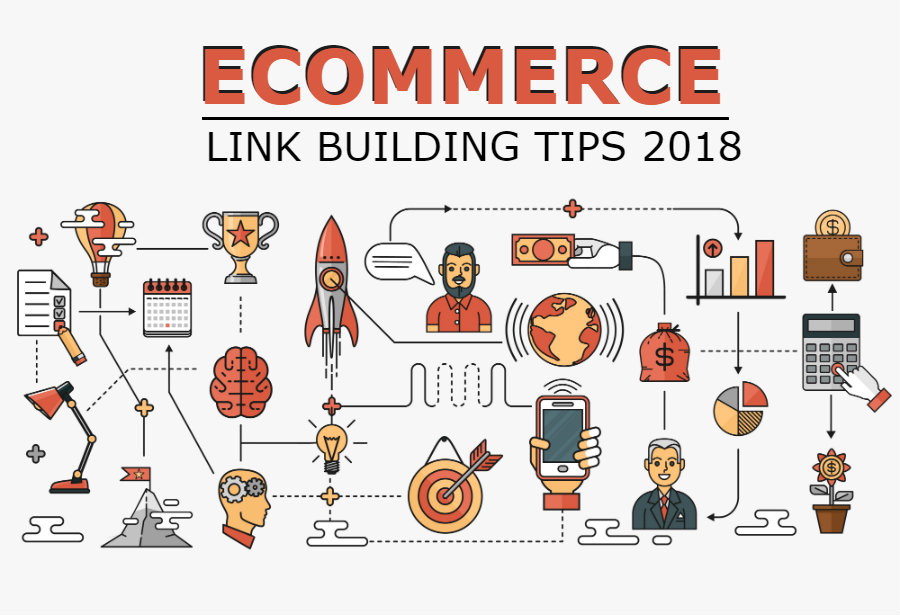12 Link Building Ideas for eCommerce Sites

Link building is hard.
That statement is simple, but the truth behind it is complicated. You know you need to get links from other websites – high-authority, relevant websites, no less – for your website to do well enough in the search engines for your customers to find you.
But how do you convince the strangers running other sites that your website is worth linking to? It’s not their job to help you out.
Asking someone else to give you a link is asking for a favor – which is awkward and very likely to get met with a “no” if you don’t have some kind of prior relationship with the person you’re asking.
The best strategies for link building are about finding ways to make the relationship more reciprocal. You want other websites to want to link to you because there’s something in it for them or their readers.
Here are a few things you can try in order to do that.
1. Guest Post on Relevant sites
This is a tried and true tactic, if you do it well. When you write a really good guest post for a website, you’re providing them something of value. Most websites that accept guest posts therefore expect and are okay with letting you include a relevant link or two back to your website in the posts you submit (but don’t overdo it, just stick with one or two).
In addition to earning you links, this tactic gives you a chance to reach a new audience that may not be familiar with your website or brand yet, potentially bringing you new traffic and followers.
For guest posting to work, you have to be strategic about it and do some real work. You should be careful to find blogs that are targeting the same audience that you want to reach and that are relevant to your industry or products. A guest post on a completely unrelated blog isn’t worth your time. Also look for blogs that have readers and authority. A guest post on a blog that no one visits that doesn’t have any real SEO authority isn’t worth your time either.
Once you’ve identified blogs that are worthwhile targets for guest posts, take some time to research the topics they cover, the style they write in, and who’s reading them. Any topic you pitch needs to be valuable to their audience for them to accept it. And while it does require a lot of work, make sure the post you write for them is top-notch content. At worst, lazy content won’t get published and you won’t earn links after all. But even if it does get published, it won’t convince anyone in their audience to come check you out.
2. Create Content Partnerships with Relevant Sites
There are brands out there that provide something similar or complementary to what you sell, without being direct competitors. These are good brands to consider for content partnerships.
You can work out a deal to create content for them (with some links back your website), while they make content for you (with links back to theirs). On both sides, you have to make sure that the content created makes sense for the other brand’s audience and is relevant and fits in with their overall content strategy.
Or you can think of ways to create content together, like joint webinars or working together on a research study. By working together, you can tap into the talent and resources that you both have to offer and expand your audiences by reaching all of the people both of you have attracted. And you’ll both get some new external links in the process.
3. Partner with Local Businesses
When you’re an eCommerce business, “local” doesn’t necessarily mean the same thing as it does when you have a business with a storefront.
Even so, your business is based somewhere. There’s a local community you can get involved with to create new connections and opportunities. Get out to local networking events and get to know some of the businesses in the area.
The connections you make in your own business community can turn into partnerships that benefit both of you, including in the form of more links to your website. If you join local professional or industry organizations, you can get links in their directories or by participating in their events or marketing. A local business owner selling complementary or related products to yours can become a promotion partner. If you sell dog collars, the local business owner that sells homemade dog treats could promote your collars in a blog post, while you promote her treats in a giveaway that raises her profile while benefiting your customers as well.
Turning local relationships into partnerships that benefit you both (and earn you links) can require some creativity, but it can be a useful way to increase awareness of your brand and earn some valuable links at the same time.
4. Look for Sponsorship Opportunities
There are definitely events and organizations in your industry that seek sponsorships. Becoming a sponsor will cost you money, but the money pays off both in good will from the community that appreciates those events or organizations, along with links back your website and mentions of your brand in any materials associated with the event or put out by the organization in relation to your sponsorship.
This is a good way to earn karma and good PR along with links.
5. Offer Free Products for Review
Look for websites that do product reviews for items similar to what you sell and reach out with an offer to provide them with a free product in exchange for a review.
Obviously, this idea only works if you’re confident in your products (which you should be!). You can’t demand good reviews, you can merely hope for them. But if you make the offer specifically to website owners you’re confident are a good fit for your product, getting reviews raises (hopefully positive) awareness of your product and will usually earn you a link back your website as well.
6. Host PR-worthy Events
Branded events can take a lot of different forms. You could host an awards dinner for your industry, put on a concert, or create a workshop. Whatever event you come up with, if it’s interesting, exciting, or helpful, then it’s PR-worthy. You can promote it to relevant publications and writers to drum up interest and get coverage of it around the web. With that coverage will inevitably come links.
Be aware that putting on an event is costly. It will probably be more worth the cost if you have goals for it that go beyond earning links – such as larger media attention, new customers, or some other benefit to be a part of your overall goal. But it’s definitely a good way to earn links as well.
7. Start Charity Projects
There are a lot of websites that are happy to amplify any charitable projects. It’s an easy way for them to feel like they’re helping out. If you set up a charity drive through your business, start a scholarship, or choose a week to donate a percentage of all your profits to a notable cause – those are all things that other websites are likely to cover or promote to their own readers.
Again, this is a strategy that will have a cost for you and is best to do for reasons other than just getting links (like in this case, helping other people), but it can be a good way to earn links as well.
8. Do Original Research
Buzzsumo’s research into the what types of content most consistently earn links found that original research is one of the most reliable ways to build links to your website. If you wonder why that might be, just look back at the beginning of this paragraph. Whenever someone cites a statistic or finding that comes from your research, they’ll link back to you.
Creating original research isn’t necessarily easy, but it’s very effective and can be worth the resources you put into it. Consider questions that your readers and other businesses in your industry have that you could help answer with a survey or analysis. If you see an opportunity for statistics or research that hasn’t been done (or that you can do better), take it!
9. Look for Brand Mentions Around the Web
Anytime someone mentions your brand around the web, it’s an opportunity for a link back your website.
First you want to find websites that have mentioned your brand. You can use Google for this, but can probably find more websites faster with a paid tool like Fresh Web Explorer. You should also set up a Google Alert for your brand name so you’ll get an email every time a website mentions your website anew moving forward.

Then, try to identify information on who’s running that website so you can contact them to ask them to add a link to your website where they mention your brand. For this tactic, you take time to visit the webpage before you contact anybody to make sure that:
- The website is actually mentioning your brand and didn’t just happen to use a phrase that included your brand name (this is especially important if you have a brand name that includes words people regularly use); and
- The mention of your brand name is positive. Chances are, a website owner that doesn’t like your brand or product isn’t going to help you out with a link.
You’re still asking a stranger to do you a favor here, so there’s a good chance a lot of people you contact will ignore you or refuse to make the change. But since you know these are websites where you’re on their radar and they’ve already mentioned your brand, they’re more likely to add your link than someone with no connection to your brand at all.
10. Look for Relevant Broken Links Around the Web
Broken link building has become a pretty big subset of link building in recent years. The idea is that if you can find examples on another website of a link that no longer works that previously went to content similar to something you’ve created, you can contact the website owner to recommend they change the link to your resource.
You’re doing something helpful for them by finding a broken link they don’t know is there yet and suggesting an easy replacement, which means they’re that much more likely to take your suggestion and add your link to their website.
Finding relevant broken links can be time consuming, but there are SEO tools that can help make it a little easier and faster. You can start with this tactic by looking for examples of broken links likely to match content you already have, but you can also expand this strategy to begin creating high-value content that can would make a good replacement for broken links you find.
11. Feature Influencers
People tend to link to websites they know, and they’re that much more likely to link to a website that mentions them in a positive light.
Identify some of the most important influencers in your industry and consider if there are some good ways to collaborate with them. You could ask them to provide a quote for a blog post you’re working on or if they’ll be the featured guest in a webinar you’re setting up. If you can offer them something that serves to help them promote their brand, they’ll be more likely to participate and to promote the content you’ve featured them in.
This can be tricky to do well because the more well known an influencer is, the more often they’ll be getting requests like this from other people. You don’t want to be one more annoyance in their inbox, but you do want to start a mutually beneficial relationship with them.
Make sure you really think about what you can offer them here and consider reaching out to people and brands that aren’t super well known just yet. That person in your industry with 1,000 followers is going to be quicker to help you out then the guy with 1 million, but still provides an opportunity to expand your reach.
12. Feature Customer Stories
This is good marketing advice in general. When your potential customers can see positive stories from your current customers, it makes them more likely to convert. But it can also be helpful for link building.
A good customer story can serve as a case study to demonstrate principles someone might point to evidence of in a blog post. For example, that writer claiming that a good pair of running shoes really does make a difference would link to your customer story about someone who increased their running time after buying your shoes.
If you’re able to capture a particularly moving story, it could inspire people to share it due to the emotion it evokes. The couple that found each other through their shared love of your products and got married in spite of great odds could leave people feeling inspired and wanting to share the tale.
People relate to people, so creating content that features the people your brand exists for and because of can give other people something to connect with. It’s those connections that often lead to shares and links.

